रस

रस की अवधारणा भारतीय कविता की एक भव्य पुरानी अवधारणा है। रस को संस्कृत साहित्य का सर्वोच्च मूल्य माना गया है। यह सौंदर्य सुख का दूसरा नाम है। नाट्यशास्त्र के रचयिता भरत मुनि को रस सिद्धांत के प्रथम आचार्य के रूप में जाना जाता है। एक प्रसिद्ध दार्शनिक अभिनवगुप्त ने भरत मुनि द्वारा प्रतिपादित रस सिद्धांत की व्याख्या की है।भरत मुनि ने आठ रसों का प्रतिपादन किया है । उनके नाट्यशास्त्र के अनुसार, प्रत्येक रस का एक पीठासीन देवता और एक विशिष्ट रंग होता है। उन्होंने निम्नलिखित की स्थापना की: 1. श्रृंगारम (प्रेम, आकर्षण): पीठासीन देवता - विष्णु; रंग- हल्का हरा। 2. हास्यम (हँसी, हास्य): पीठासीन देवता - प्रमाता; रंग- सफेद। 3. रौद्रम (रोष): पीठासीन देवता - रुद्र; रंग- लाल। 4. करुण्यम (करुणा, दया): पीठासीन देवता - यम; रंग- ग्रे। 5. बिभत्सम (घृणा, घृणा): पीठासीन देवता - शिव; रंग- नीला। 6. भयनाकम (डरावनी, आतंक) - पीठासीन देवता - काल; रंग - काला। 7. वीरम (वीर मूड) - पीठासीन देवता - इंद्र; रंग - पीला-सा । 8. अद्भुतम (आश्चर्य, विस्मय) - पीठासीन देवता - ब्रह्मा; रंग- पीला। Sandal S Anshu, Satna